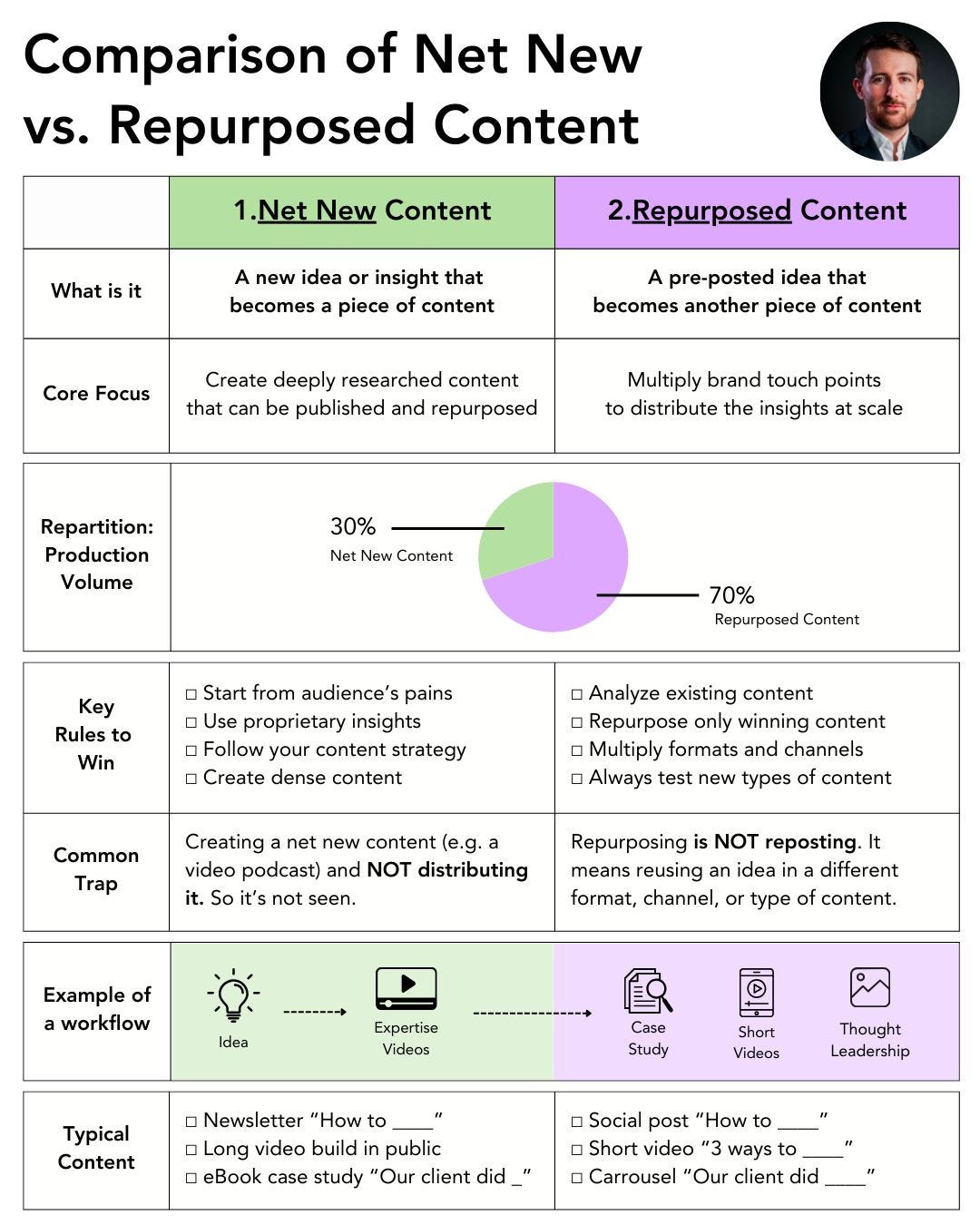Content Repurposing in 2025: What you need to know
This system turns your best ideas into near-infinite content, more clients & less stress
Hello, welcome to this edition! 👋
On this occasion, we’re diving today into this misunderstood and underutilized systems in B2B content marketing: repurposing.
Most people think repurposing means just “reposting content on other platforms”.
Today, you’ll find out why that’s dead wrong and why I believe content repurposing is the #1 skill a B2B marketer or founder can have in their toolkit.
So here’s what you’ll learn in this edition:
What is repurposing exactly
Why you NEED to be repurposing your content
The real goal of repurposing
The 30/70 framework that generated 50M+ views in 3 years
First, what does it mean to “repurpose content”?
Let me make it clear right away. Repurposing doesn’t mean simply reposting the same content after a few months. It doesn’t mean publishing on different channels at the same time (that’s crossposting).
Repurposing means reusing the core idea of a piece of content to turn it into other pieces of content. It’s a great occasion to change the type of content, the format, and the channel.
I use my repurposing system DAILY to publish content.
Here are 3 examples:
I turn a newsletter into a YouTube video and several shorts
I turn a LinkedIn post into a newsletter
Here’s an other repurposing route I used:
⇒ I’m going to teach you exactly how to do this in the Repurposing Factory
Example: What repurposing looks like in practice
Let’s say you run a B2B cold email deliverability tool. You publish a guide called:
“Why 82% of B2B cold emails never land in the inbox… and what to do about it.”
From that single guide, you can spin out:
All of these pieces come from the ideas found in the original guide.
You didn’t have to write 5 new ideas. You just repurposed one net-new content idea into multiple posts.
The 2 major problems I see when working with B2B companies on their content strategy:
1/They misunderstand what repurposing means:
2/Or they’re afraid to repurpose:
There are many misconceptions about repurposing. Yet it's probably the most powerful system for B2B brands in 2025. Because what these people don’t realize is that repurposing is not about just “saving time” or “repeating yourself”...
Repurposing allows you to build an asset engine that compounds over time, boosts your authority, and unlocks leverage over your content.
It’s a system that frees up your mental bandwidth so you can focus on strategy.
And it’s the exact same system that helped me generate:
50 million views in 3 years
Hundreds of monthly leads
Thousands of reusable assets
…all without burning out on the content creation process.
Repurposing is about strategic repetition
Think about the creators and founders you admire:
They don’t publish 100 new ideas a month.
They go deep on 3-5 key messages, and remix them across the year.
The reason is simple: our brain needs repetition to understand and adhere to a message.
Now you know why I believe repurposing content is so valuable…
Let me show you how to do it for your own business:
Here’s a snapshot on how to repurpose content:
In theory, the system is simple:
Step 1: Create new content. As dense and valuable as possible.
Step 2: Publish and learn. Observe what resonates with your audience and refine your positioning.
Step 3: Repurpose. Turn the content into multi-format assets to distribute your messaging at scale.
But in practice, you need to follow key rules.
And this starts by separating Net New Content vs Repurposed Content:
Net new content is a new idea or insight that you turn into a piece of content.
It’s what everyone focuses on most… but really it should only account for about 30% of your content creation efforts.
Creating net new content involves taking your audience’s pain points and your proprietary insights to create deeply researched content.
A typical example is long-form newsletters, videos, and podcasts.
Your goal with net new content is simply to put good content out there and see what resonates with your audience.
When you do this, you create a feedback loop. Your audience tells you (via metrics like engagement and comments) what they most want to hear.
Using these insights from the audience feedback loop, you create repurposed content.
This is the type of content that should take up 70% of your content creation workflow. Not because it’s easier, but because it’s more strategic.
You're taking proven messages and distributing them across more touchpoints, in various formats your audience might prefer.
For example, you could:
Turn your net new content into a “3 ways to ____” LinkedIn post.
Or slice a podcast interview into 45-second video Shorts.
Or turn a case study into a visual carrousel.
⇒ I’m going to teach you exactly how to do this in the Repurposing Factory
So, to recap, the 30/70 rule:
30% of your content workflow = Net New Content (your original insights)
70% = Repurposed Content (your asset engine)
When you have an unshakeable repurposing system, you no longer need to scramble to come up with new content.
You simply turn to your system and convert a single good idea into weeks, even MONTHS, of content to fuel your pipeline.
Alright that’s the end of this newsletter. I hope it helped you! Thanks for reading :)



















Repurposing from online to offline gives content a new lustre.
When you can hold it in your hands, the virtual becomes *real*.
(obv. not for everyone in every case, but irreplaceable nevertheless)
Has this course gone live?